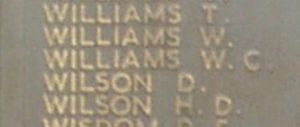Dolwyddelan is a village and community in the ancient county of Caernarvonshire, which sits on the main A470 road between Blaenau Ffestiniog and Betws-y-Coed. The village is home to the magnificent Dolwyddelan Castle, one of the chain of Welsh fortresses originally built by Llewelyn the Great. The village was for several centuries part of the Gwydir Estate and was ruled from Gwydir Castle by the Wynn family. The main industry in the area were the local slate quarries, and this can be seen by the number of slate workers commemorated on the village war memorial, which is situated by the village Church. This memorial was originally unveiled in July 1922 to commemorate local men who had died in the First World War, then the names of local men who died in the Second World War were added later to the memorial.
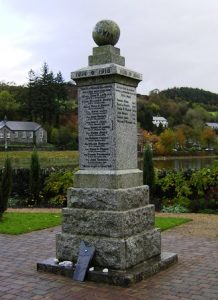
The Great War, 1914-1918
John Robert Davies, Private, 6437, Cheshire Regiment. John born at Birkenhead on 15 August 1882, the son of Griffith Davies and Elizabeth Davies (nee Brillerford). His parents were both originally from Llangollen. He worked as a labourer at Liverpool prior to enlisting into the Cheshire Regiment on 10 December 1900 and was posted to the 2nd Battalion, Cheshire Regiment. John then saw active service in South Africa during the Anglo Boer War, then spent a year back in Britain before going to India with the battalion. He spent six years serving in India before returning home in January 1909. John then fathered two illegitimate children with Martha Hughes, a young woman from Mold who was in service in Liverpool, before marrying her on 22 February 1913, and the couple then had two more children. Martha resided with the two younger children at Rodney Street, Birkenhead, whilst the two elder ones appear to have been sent to live with Mary Winifred Williams, at 2, Pentre Bont, Dolwyddelan. As a former soldier, John was an Army Reservist and was mobilised at the outbreak of war, joining the 3rd Battalion, Cheshire Regiment at Chester. He embarked for France on 13 September 1914, joining D Company of the 1st Battalion, Cheshire Regiment. The battalion was attached to 15 Brigade, 5th Division and had taken part in the Battle of Mons and the subsequent retreat through Le Cateau to the Marne where the German attack was halted. John joined the battalion in time to take part in the advance to the Aisne, where the Germans dug in along the Chemin-des-Dames Ridge, thus initiating the building of the trench system which became known as the Western Front. On 7 October the 1st Cheshire’s entrained for Amiens, before heading to Flanders with the rest of the 5th Division, taking over positions around Festubert and immediately came into contact with the Germans. Several skirmishes ensued over the coming days, then on 21 October the 1st Cheshire’s launched an assault on La Bassée, in an attempt to drive the Germans back. John was wounded in the thigh and taken prisoner by the Germans at La Bassée on 21 October 1914 and was taken to Gottingen POW Camp, where his wounds were treated. In December 1916 he was transferred to Leysin in Switzerland, after having been diagnosed as suffering from tuberculosis. He was repatriated back to Britain the following spring and was treated at the 1st London General Hospital at Camberwell, before being discharged from the army as medically unfit on 25 October 1917 and returned to his wife and children at Birkenhead. John died of tuberculosis at home at Rodney Street on 28 February 1918. The 36-year-old was buried in Neston Cemetery on 4 March. John is not commemorated on the Dolwyddelan War Memorial.
William John Evans, Private, 45936, South Lancashire Regiment. William was born at Dolwyddelan in 1899, the son of Hugh Evans and Annie Evans (nee Watson). By 1901 the family had moved to 107, Clydach Road, Ystradfodwg, where Hugh had found work as a coal hewer, then by 1911 William and his brother Emrys were residing with their grandparents, William, and Judith Evans, at 2, Pentre Bont, Dolwyddelan. William enlisted into the army at Cardiff in the summer of 1917 and upon being drafted to France in the summer of 1918 was posted to the 2/4th Battalion, South Lancashire Regiment, which was attached to 172 Brigade, 57th (West Lancs) Division and was at Gommecourt. Soon after his arrival, the division was transferred north to the Fampoux Sector, near Arras, in preparation for the forthcoming great Allied offensive. The offensive was launched on the Somme front on 21 August 1918, and the Allies began driving the Germans back towards the Hindenburg Line. The 2/4th South Lancs attacked Hendecourt on 28 August, and over the coming days advanced past Henin towards the Hindenburg Line. The line was broken on 29 September, opening the door for the Allies to drive the Germans back towards the German frontier. The 57th Division then took part in heavy fighting whilst advancing towards Cambrai. William was killed near Fontaine Notre Dame on 6 October 1918 as the division neared the outskirts of Cambrai itself. The 19-year-old is buried in Anneux British Cemetery, France. William is not commemorated on the Dolwyddelan War Memorial.
Albert Jones, Sergeant, 9433, Welsh Regiment. Albert was born in about 1885, the son of Owen Jones and Mary Jones, of Llety-Fadog, Dolwyddelan. He enlisted into the Welsh Regiment on 20 July 1907, and by 1911 was stationed in Egypt with the 1st Battalion, Welsh Regiment. Albert was in India with the 1st Welsh prior to the war, and was attached to the 129th Indian Field Ambulance, which was in the same 7th (Meerut) Division as the 1st Welsh. (The 1st Welsh left Karachi on 20 November 1914, returning to England to join the 28th Division, but Albert remained with the 129th Indian Field Ambulance.) The 7th (Meerut) Division left India soon after the outbreak of war and from 12-14 October landed at Marseilles, before entraining for Flanders. The division saw its first major action on the Western Front during the Battle of La Bassée, and then at Messines and Armentieres in October and November 1914. Albert came home on leave in January 1915, then re-joined the 129th Indian Field Ambulance shortly afterwards. The division suffered terribly during its first winter in Flanders, then saw heavy fighting in the spring of 1915 during the Battles of Neuve Chapelle, Aubers Ridge, Festubert and Loos. Albert had by now begun to struggle with ill-health and he was discharged from the army as medically unfit on 24 November 1916. He then found work as a police constable at Liverpool. He married his wife Ellen soon afterwards. Albert’s health continued to plague him over the coming years and following Ellen’s death in January 1919 he returned home to Dolwyddelan with their son. Sadly, Albert died of phthisis at Dolwyddelan on 18 October 1919. The 34-year-old was buried with his wife Ellen in Dolwyddelan Cemetery. Albert is not commemorated on the Dolwyddelan War Memorial.
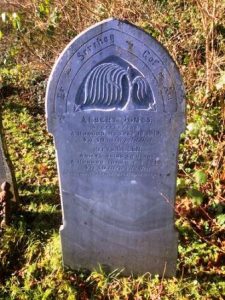
Alfred Lloyd Jones, MM, Sergeant, 20453, Machine Gun Corps. Alfred was born in 1895, the son of Robert Jones and Elizabeth Jones, of Shop Back, Dolwyddelan. His mother died soon after his birth and the following year his father married Ellender Sumner. The family then moved to Glan Lledr, Penmachno by 1901 and to Ty’n Llidiart by 1911. Alfred worked as a farm servant after Penmachno before moving to the South Wales valleys to work as a coalminer, and resided at 7, Sarah Street, Merthyr Vale. He married Gladys Cridland at Caerphilly on 30 March 1914 and on 17 January 1915 their daughter, Alice Maud Jones, was born. Alfred enlisted at Caerphilly into the 10th Battalion, Gloucestershire Regiment soon after the outbreak of war and on 5 September 1914 Gladys was admitted into the Merthyr Tydfil Union Workhouse, stating that she had been deserted by Alfred. The 10th Battalion, Gloucestershire Regiment formed at Bristol in September 1914, joining the 26th Division on Salisbury Plain. The battalion landed in France with the division on 8 August 1915, then immediately transferred to 1 Brigade, 1st Division. Alfred was transferred to one of the divisional Machine Gun Companies soon afterwards and in September 1916 was awarded the Military Medal, for bravery during the Somme Battles. In February 1918 the Divisional Machine Gun Companies were merged to form the 1st Battalion, Machine Gun Corps. The division was at the time holding positions in the Ypres Salient. To the south, the Germans launched a great offensive along the Somme front on 21 March 1918, then on 9 April launched a second offensive along the Lys Valley, in Flanders. The 1st Machine Gun Battalion was moved to positions at Le Quesnoy that day and soon came under heavy fire. After two days of fighting the battered battalion was moved back to Fouquières for a rest, then on 18 March moved into positions at Gosnay, ready to support a counterattack on the La Bassée Canal. On 20 April 1918 the 1st Division managed to drive the Germans out of Route A Keep, then cleared the Germans from the north of Givenchy, however Alfred had been killed in action during the fighting that day. The 23-year-old has no known grave and is commemorated on the Loos Memorial, France. Alfred is not commemorated on the Dolwyddelan war memorial.
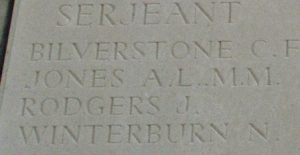
John Evan Jones, Private, 202040, South Lancashire Regiment. John was born in 1893, the son of Ellis Jones and Elizabeth Jones, of Ty Newydd, Garnedd, Dolwyddelan. He left home as a young man and by 1915 was residing at 16, Gorsey Lane, Warrington, where he worked as an agricultural implement maker. John enlisted into the 2/4th Battalion, South Lancashire Regiment at Warrington in November 1915 and was initially placed on the Army Reserve. John was mobilised on 24 January 1916 and joined the battalion at Ashford, where it was attached to 172 Brigade, 57th (West Lancs) Division. He embarked for France with the battalion on 15 February 1917, and upon disembarking at Boulogne, the battalion entrained with the rest of the division for Bailleul, before the division moved into the Bois Grenier Sector for trench initiation and training. The division later moved to positions near Ypres, where it took part in the Second Battle of Passchendaele later that year. In 1918, the division took part in the 1918 Battle of the Scarpe, and at the Battle of Drocourt-Queant, fighting on the Hindenburg Line during the Battle of the Canal du Nord, before taking part in the Battle of Cambrai, where the Division helped capture Cambrai itself. The division continued to advance and took part in the Final Advance in Artois, before occupying Lille. John survived the war but had contracted tuberculosis by the time he was discharged from the army on 4 February 1919, and he returned home to Dolwyddelan in poor health. He died of pulmonary tuberculosis at Gwernhywel Ganol, on 1 December 1920, aged 27. His place of burial is currently unknown, so John will be commemorated in the United Kingdom Book of Remembrance, at their HQ at Maidenhead, until his grave can be located. John was accepted for commemoration by the CWGC on Friday 13 October 2023, after having been forgotten for over a hundred years.
John Parry Jones, Private, 70083, Royal Welsh Fusiliers. John was born in 1893, the son of Owen Parry Jones and Ellen Parry Jones (nee Roberts), of Aber Farm, Roman Bridge, Dolwyddelan. He worked as a slate maker prior to enlisting into the Royal Welsh Fusiliers at Llanfairfechan during the summer of 1917 and was posted to France to join the 2nd Battalion, Royal Welsh Fusiliers. The battalion was an exceptionally well documented one, which during its time at war had seen such well-known men as Siegfried Sassoon, Robert Graves, Frank Richards and Captain James Charles Dunn serve with it. It had been on the Western Front since the early weeks of the war and by the summer of 1917 was attached to the 33rd Division. On 6 February 1918 the battalion was transferred to 115 Brigade, 38th (Welsh) Division, which was holding a section of line in the Sailly-sur-la-Lys sector. The division moved to positions north of Albert, at Bouzincourt Ridge, at the end of March 1918, relieving the battered 2nd and 47th Divisions. It held this sector, carrying out minor operations and trench raids, over the coming months, before taking part in the great offensive of 21 August 1918, and began its advance towards the Hindenburg Line. During that first day, the Division launched an assault across the river Ancre, as part of the greater Allied offensive, and over the coming days captured Thiepval Ridge, Pozieres, Mametz Wood and High Wood, whilst advancing across the old Somme battlefields of 1916. During the night of 31 August, the Germans withdrew from Lesboeufs, so in the early hours of 1 September 1918 the 2nd RWF moved forward, while 114 Brigade assaulted the neighbouring village of Morval. The 2nd RWF crowed the Morval to Le Transloy road, then came into contact with the enemy shortly afterwards near the village of Sailly-Saillisel. John was killed in action at Sailly-Saillisel that day, on 1 September 1918. The 25-year-old is buried in Sailly-Saillisel British Cemetery, France. His brother, Robert Owen Jones, was killed on 21 March 1918.
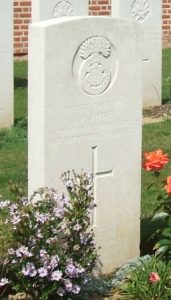
Owen Jones, Private, 20767, South Wales Borderers. Owen was born in 1892, the son of Harry Jones and Elizabeth Jones (nee Owens), of Glan William, Dolwyddelan. He enlisted into the 10th Battalion, South Wales Borderers at Colwyn Bay early in 1915. The battalion was attached to the 43rd (Welsh) Division and trained in North Wales before moving to Winchester in the summer of 1915, where the formation became renumbered 115 Brigade, 38th (Welsh) Division. The Division began moving to France on 2 December 1915 and moved to the Nursery Sector near Fleurbaix for trench initiation alongside the Guards Division. The Division then held a sector of the line near Cuinchy before marching south to the Somme sector in June 1916 to take part in the assault on Mametz Wood. The first attack on the wood was launched on a two-battalion front on 7 July, but failed, and the Divisional Commander, Sir Ivor Philipps, was replaced before the Division attacked again on a two Brigade front on 10 July 1916. After two days of ferocious hand-to-hand fighting, the wood was cleared up to its northern edge, before the battered Division was relieved. It then took over a section of the front at Hébuterne before moving to the Ypres Salient and taking over the Canal Bank sector at Boesinghe. The infantry battalions of the Division then began carrying out the normal pattern of rotation in the trenches, four days in the front, four in support and four in reserve, whilst also working on trench improvement, digging new trenches, and carrying out regular patrols and trench raids. On 31 July 1917 the Division launched its famous assault on the Pilckem Ridge, capturing Iron Cross and reaching its objective of the Steenbeek, then played a supporting role in the Battle of Langemarck. The Division was transferred to the Sailly-sur-la-Lys sector in September and remained in the area over the winter. Owen was transferred to the 11th SWB in the same brigade around this time, but when the 11th SWB was disbanded in February 1918, he was transferred to the 2nd Battalion, South Wales Borderers, which was attached to 87 Brigade, 29th Division, and was holding the line on Passchendaele Ridge. To the south, the Germans launched the opening phase of their great offensive along the Somme front on 21 March 1918, then on 9 April launched the second phase along the Lys Valley. The 29th Division was relieved by the 41st Division that day and moved out of the line, before being rushed to positions at Les Haies Basses on the evening of 10 April. On the following morning the Division was hit by the Germans and the 29th Division was forced to withdraw, as it was flanked on the left. Several weeks of desperate fighting followed, before the Germans turned their attention further south, to the Champagne Sector, and the line in Flanders quietened down. Owen was killed in action whilst the 2nd SWB were holding the line near Le Grande Hasard on 14 June 1918. The 26-year-old was buried in Cinq Rues British Cemetery, Hazebrouck, France.
Robert Owen Jones, Gunner, 213527, Royal Field Artillery. Robert was born in 1898, the son of Owen Parry Jones and Ellen Parry Jones (nee Roberts), of Aber Farm, Roman Bridge, Dolwyddelan. He enlisted at Bangor into the Royal Field Artillery and was posted to A Battery, 330th Brigade, Royal Field Artillery, which was attached to the 66th (2nd East Lancs) Division. The Division concentrated on the Western Front by 16 March 1917 and moved to the Flanders Coast. At the end of September 1917, the Division moved to Ypres, and took part in the Battle of Poelcapelle. It then moved south to the Somme sector, taking over positions around Tincourt and Roisel to the east of Péronne. During the early morning of 21 March 1918, the Germans attacked the British, using specialised Stormtroopers who advanced under the cover of a thick mist, and smashed their way through the British lines. Robert was killed in action near the small village of Nobescourt that day. The 20-year-old has no known grave, so is commemorated on the Pozières Memorial, France. The 66th Division was virtually annihilated in the days following the German offensive and was reduced to a training cadre. His brother, John Parry Jones, was killed on 1 September 1918.
Owen Lloyd, Private, 3089, Royal Welsh Fusiliers. Owen was born on 14 November 1895, the illegitimate son of Annie Lloyd, of 3, Singrig, Dolwyddelan. He was raised by his grandmother Mary, then after his mother married Ellis Roberts in 1906, Owen went to live with her at Aber Beinw, Dolwyddelan. Owen worked as a farm labourer prior to enlisting at Llanrwst into the 5th Battalion, Royal Welsh Fusiliers soon after the outbreak of war. The battalion was a Territorial Army unit which mobilised at Flint as part of North Wales Brigade, Welsh Division and moved to Conway until the end of the month, before moving to Northampton. In December the Division moved to Cambridge and then in May 1915 to Bedford, where the Division was numbered and the formation became 158 Brigade, 53rd (Welsh) Division. On 19 July 1915 the entire Division sailed from Devonport for Imbros and on 9 August 1915 landed at Suvla Bay. The infantry moved off the beaches across the Salt Lake, under shellfire, into the scrub covered Chocolate Hill, but due to a lack of maps and no knowledge of the terrain, many of the units became disorientated, and the situation became chaotic. Owen survived the worst of the fighting over the next few days, and the entire Gallipoli front then settled back down into a stalemate. On 22 September 1915 the 5th RWF were at work at West Beach, constructing dugouts, when Owen was killed by a Turkish shell. The 19-year-old was buried in Hill 10 Cemetery, Gallipoli.
Arthur Denis Worsley Lowe, MC, Second Lieutenant, South Wales Borderers. Arthur was born in Ireland on 28 April 1895, the son of Horace Arthur Lowe and Mary Amelia Lowe (nee Worsley). His father was a chemist from Manchester, and after living in Ireland for a while moved his young family out to France, then to Stockport, before settling at Colwyn Bay by 1901. The family then moved again, settling at The Plas, Dolwyddelan. Arthur was educated at Dean Close School, Cheltenham. He enlisted as a Private into the 18th Battalion, Royal Fusiliers, but was commissioned as Second Lieutenant into the 3rd Battalion, South Wales Borderers, on 16 June 1915. Arthur embarked for France on 23 October 1915 and was posted to the 11th Battalion, South Wales Borderers, when the battalion arrived in France on 4 December, as part of 115 Brigade, 38th (Welsh) Division. The Division moved to the Nursery Sector near Fleurbaix for trench initiation alongside the Guards Division. The Division then held a sector of the line near Cuinchy before marching south to the Somme sector in June 1916 to take part in the assault on Mametz Wood. The first attack on the wood was launched on a two-battalion front on 7 July but failed due to inadequate artillery support and too few attacking troops. Arthur was wounded in the attack on Mametz Wood on 7 July 1916 and spent some time in hospital before being posted to the 2nd Battalion, South Wales Borderers. The battalion was attached to 87 Brigade, 29th Division and had returned to the Somme following a period of refitting, to take part in the latter stages of the Somme offensive. Arthur was awarded the Military Cross in an attack just south of Le Transloy on 27 January 1917. The citation, published in the London Gazette of 12 March 1917, stated: ‘For conspicuous gallantry and devotion to duty. When the attack was temporarily held up by machine gun fire, he led his party to this place and successfully bombed the enemy gun teams, thus enabling the attack to push on. Later, he himself captured six prisoners.’ In the Spring of 1917 the Division fought at the Battle of the Scarpe, which was part of the Arras Offensive, seeing heavy fighting around Monchy-le-Preux, and then moved further north to Ypres, initially to hold the line whilst other units had been withdrawn for specialist training, in readiness for the Third Battle of Ypres, which opened on 31 July 1917. The 29th Division went into reserve whilst the first attacks, the Battle of Pilckem Ridge, took place, then on the night of 14-15 August the 2nd SWB moved into the line facing Langemarck, ready to launch another offensive. On the following day the battalion reconnoitred the ground in front of them, and laid white tapes in No Man’s Land, to guide the attacking troops, and at dawn on 16 August 1917 the 2nd SWB launched an attack on Langemarck. The battalion successfully took its two objectives but had suffered 163 casualties. The Division then had another period out of the line to rest and refit before taking part in further fighting near Poelcapelle. Arthur was killed in action here on 4 October 1917, when he, together with Second Lieutenant Gibson, had been sent to reconnoitre prior to the 2nd SWB moving up to take over the new front line. The 22-year-old has no known grave and is commemorated on the Tyne Cot Memorial, Belgium.

Douglas Graham McNaughton, Lance Corporal, 20291, Royal Welsh Fusiliers. Douglas was born in 1896, the son of David McNaughton and Elizabeth McNaughton (nee Evans), of 4, Prince Terrace, Dolwyddelan. He enlisted into the Royal Welsh Fusiliers on 16 January 1915 and was posted to Kinmel Park to join the 20th Battalion, Royal Welsh Fusiliers, a training unit for young soldiers. Douglas spent twenty months at Kinmel Park before his health began to break down and he was discharged from the army as medically unfit on 14 September 1916 after being diagnosed as suffering from phthisis. Douglas returned home to Dolwyddelan, but his health continued to wane, and he eventually died of tuberculosis on 24 February 1922. The 25-year-old was buried in Dolwyddelan Cemetery. Douglas is not commemorated on the Dolwyddelan war memorial, nor is he commemorated by the CWGC.
Rhys Owen Morris, Driver, W/674, Royal Field Artillery. Rhys was born in 1892, the son of Rhys Morris and Elizabeth Anne Morris (nee Owen), of Llan Cottage, Dolwyddelan. He worked as a farm labourer prior to moving to South Wales to find work at New Tredegar in the coalmines. Rhys enlisted at Bargoed into the Welsh Divisional Royal Field Artillery soon after the outbreak of war and was posted to North Wales for training. The newly raised Welsh Division had no artillery guns to start with, so the men trained with telegraph poles strapped onto farm carts, until their guns finally arrived. Once properly organised, Rhys joined D Battery, 122nd Brigade, Royal Field Artillery and the division was numbered to the 38th (Welsh) Division, before moving to Winchester in the summer of 1915 to complete its training. The Division began moving to France on 2 December 1915 and moved to the Nursery Sector near Fleurbaix for trench initiation alongside the Guards Division. The Division then held a sector of the line near Cuinchy before marching south to the Somme sector in June 1916 to take part in the assault on Mametz Wood. The first attack on the wood was launched on a two-battalion front on 7 July, but failed, and the Divisional Commander, Sir Ivor Philipps, was replaced before the Division attacked again on a two Brigade front on 10 July 1916. After two days of ferocious hand-to-hand fighting, the wood was cleared up to its northern edge, before the battered Division was relieved. It then took over a section of the front at Hébuterne before moving to the Ypres Salient and taking over the Canal Bank sector at Boesinghe. The infantry battalions of the Division then began carrying out the normal pattern of rotation in the trenches, four days in the front, four in support and four in reserve, whilst also working on trench improvement, digging new trenches, and also carrying out regular patrols and trench raids. On 31 July 1917 the Division launched its famous assault on the Pilckem Ridge, capturing Iron Cross and reaching its objective of the Steenbeek, then played a supporting role in the Battle of Langemarck. The Division was transferred to the Sailly-sur-la-Lys sector in September and remained in the area over the winter. At the end of March 1918, the division was transferred south to positions north of Albert, at Bouzincourt Ridge, relieving the battered 2nd and 47th Divisions, however the Divisional Artillery remained in Flanders, to counter the growing threat of a German offensive in the Lys Valley. The Germans then launched a great offensive here on 9 April 1918, smashing the Allied lines and beginning a lengthy spell of desperate fighting. The 38th Divisional artillery was still in the Sailly Sector when the Germans hit, and lay covering fire down on the Houplines Sector, whilst the Portuguese Division in front broke and fled, forcing the men to withdraw their guns back towards the river to Pont Nieppe. Heavy fighting continued on the following day whilst the artillery supported the 34th Division, which was struggling to hold the line, and after the Germans captured Le Bizet, the guns were forced to withdraw again, to Neuve Eglise, where it began firing upon the Germans on the front between Steenwerck and Neuve Eglise. On the following morning, 11 April 1918, the guns were forced to withdraw again, moving behind Ravelsburg Hill, where it covered the withdraw of 88 Brigade, 29th Division. The 38th Divisional Artillery, after sterling service in Flanders, was released in the middle of May and headed south to re-join the 38th (Welsh) Division, which was still holding the Bouzincourt Ridge sector, arriving at Gézaincourt by 18 May. Over the coming days the batteries set up their guns in positions between Mailly-Maillet and Colincamps, ready to support the division. Rhys appears to have been killed when the Germans fired a salvo of poisonous phosgene gas onto the battery’s positions on 29 June 1918. The 26-year-old was buried in Harponville Communal Cemetery Extension, France. His brother, William Griffith Morris, had been killed nearby just two months earlier.
William Griffith Morris, Lance Corporal, 54830, Royal Welsh Fusiliers. William was born in 1897, the son of Rhys Morris and Elizabeth Anne Morris (nee Owen), of Llan Cottage, Dolwyddelan. He worked as a farm labourer prior to the war. William enlisted at Llanrwst into the Royal Welsh Fusiliers and was sent to Kinmel Park for training. He was drafted to France in the spring of 1917 and was posted to Ypres to join the 13th Battalion, Royal Welsh Fusiliers. The battalion was attached to 113 Brigade, 38th (Welsh) Division and had moved there the previous year, following its famed assault on Mametz Wood, and had taken over the Canal Bank sector at Boesinghe. The infantry battalions of the Division then began carrying out the normal pattern of rotation in the trenches, four days in the front, four in support and four in reserve, whilst also working on trench improvement, digging new trenches, and also carrying out regular patrols and trench raids. On 31 July 1917 the Division launched its famous assault on the Pilckem Ridge, capturing Iron Cross and reaching its objective of the Steenbeek, then played a supporting role in the Battle of Langemarck. The Division was transferred to the Sailly-sur-la-Lys sector in September and remained in the area over the winter before being moved to positions north of Albert, at Bouzincourt Ridge, at the end of March 1918, relieving the battered 2nd and 47th Divisions. It held this sector, again carrying out minor operations and trench raids, over the coming months. On 22 April 1918, 113 Brigade launched an assault upon the German positions on Bouzincourt Ridge, in an attempt to regain the high ground. As soon as the men rose from their trenches, they were met with heavy machine-gun fire, as well as suffering from strikes from their own artillery barrage which were falling short. William was killed in action during the assault that day. The 21-year-old has no known grave and is commemorated on the Pozieres Memorial, France. His brother, Rhys Owen Griffiths, was killed nearby just two months later.
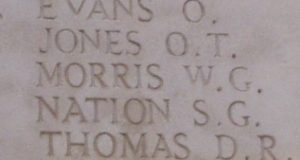
Richard Parker, Private, 19304, King’s Own (Royal Lancaster Regiment). Richard was born in 1892, the son of Anthony Parker and Anne Elizabeth Parker (nee Harper). His parents were from Cumbria, but had lived at Coetmor Farm, Dolwyddelan since before 1887. The family moved to Church Farm, Lighthorne, Warwickshire in 1898, and remained there until the outbreak of war. Richard worked for his parents prior to enlisting at Ulverston into the 8th Battalion, King’s Own (Royal Lancaster Regiment) soon after the outbreak of war. Richard joined up with the battalion at Boscombe, where it was in billets. The battalion was attached to 76 Brigade, 25th Division, and embarked for France on 26 September 1915. Richard does not appear to have embarked for France with the 8th Battalion but was instead later drafted to Salonika to join the 9th Battalion, King’s Own (Royal Lancaster Regiment), which was attached to 65 Brigade, 22nd Division. The division had been one of several British and French Divisions sent there the previous year as a result of a combined Austro-Bulgarian invasion of neighbouring Serbia, which had resulted in the Serbian army being driven back into Salonika. This Allied Force saw several major actions during its time there, during the battle of Horseshoe Hill in August 1916, then at the battle of Machukovo the following month. Further battles were fought around Doiran during April and May 1917, and finally the last major action came on 18 September 1918 at the Second Battle of Doiran. Richard was killed in action here on 19 September 1918. The 26-year-old has no known grave and is commemorated on the Doiran Memorial, Greece. Richard is not commemorated on the Dolwyddelan War Memorial.
Owen Griffith Pierce, Private, 29733, King’s Shropshire Light Infantry. Owen was born in 1891, the son of Griffith Pierce and Ellen Pierce (nee Jones), of 9, New Street, Blaenau Ffestiniog. By 1911 he was living with his uncle, Thomas Pierce, and his aunt Dorothy at Llwyn, Dolwyddelan. He enlisted at Dolwyddelan into the Training Reserve, then in the summer of 1918 was drafted to France, and was posted to the 7th Battalion, King’s Shropshire Light Infantry, which was attached to 8 Brigade, 3rd Division. The battalion had spent much of the early summer months rebuilding following heavy losses that spring. On 21 August 1918 the division took part in the opening of the great offensive along the Somme front, with 8 Brigade capturing its objectives along the Bapaume-Arras railway line. The division continued its advance over the coming days, then was relieved and moved back to Moyenville to reorganize and clean up. The 7th KSLI did not see further action until 2 September, when further advances were made, but suffered heavy casualties. On 16 September the battalion relieved the 17th Royal Fusiliers in Brigade support on the Hermies-Demicourt road and on the following day helped beat off a German counterattack. The battalion then took part in the Battle of the Canal du Nord, reaching Flesquières by the end of the month. On 1 October the 7th KSLI took part in an advance by 8 Brigade, clearing up the village of Seranvillers. Owen was killed during a further advance on the following day, 2 October 1918. The 27-year-old is buried in Ribecourt Railway Cemetery, France. A nephew, Trevor Vivian Pierce, was killed in Burma in 1946.
Hughie Prydderch, Private, 20233, Royal Welsh Fusiliers. Hughie was born in 1896, the son of Hugh Prydderch and Catherine Prydderch (nee Griffiths), of Tan-y-Castell, Dolwyddelan. His father had tragically died whilst he was young, so Hughie was raised with a brother and sister at Dolwyddelan. He enlisted at Blaenau Ffestiniog into the 14th Battalion, Royal Welsh Fusiliers soon after the outbreak of war. The battalion had been raised at Llandudno by the Welsh National Executive Committee on 2 November 1914, joining 128 Brigade, 43rd (Welsh) Division and began training at Rhyl and Colwyn Bay. On 29 April 1915 the formation became renumbered to 113 Brigade, 38th (Welsh) Division, before moving to Winchester in the summer of 1915 to complete its training. The Division moved to France on 2 December 1915 and moved to the Nursery Sector near Fleurbaix for trench initiation alongside the Guards Division. The Division then held a sector of the line near Cuinchy before marching south to the Somme sector in June 1916 to take part in the assault on Mametz Wood. The first attack on the wood was launched on a two-battalion front on 7 July, but failed, and the Divisional Commander, Sir Ivor Philipps, was replaced before the Division attacked again on a two Brigade front on 10 July 1916. After two days of ferocious hand-to-hand fighting, the wood was cleared up to its northern edge, before the battered Division was relieved. It then took over a section of the front at Hébuterne before moving to the Ypres Salient and taking over the Canal Bank sector at Boesinghe. The infantry battalions of the Division then began carrying out the normal pattern of rotation in the trenches, four days in the front, four in support and four in reserve, whilst also working on trench improvement, digging new trenches, and also carrying out regular patrols and trench raids. On 31 July 1917 the Division launched its famous assault on the Pilckem Ridge, capturing Iron Cross and reaching its objective of the Steenbeek, then played a supporting role in the Battle of Langemarck. Hughie was either wounded or invalided sick at some time and was then posted out to Salonika to join the 11th Battalion, Royal Welsh Fusiliers, which was attached to 67 Brigade, 22nd Division. Hughie was killed in action during his first major action in Salonika, during the Second Battle of Doiran, on 19 September 1918. The 22-year-old has no known grave and is commemorated on the Doiran Memorial, Greece.
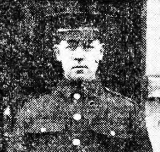
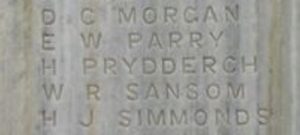
Charles Henry Roberts, Private, 204032, Royal Welsh Fusiliers. Charles was born in 1895, the son of Robert Roberts and Sarah Jane Roberts, of Ty Ucha, Penrhiw, Dolwyddelan. He worked as a furnaceman prior to the war and resided at Dolgarrog. Charles enlisted into the 4th Battalion, Royal Welsh Fusiliers at Llanrwst on 26 February 1916 and was initially placed on the Army Reserve. He was mobilised at Wrexham on 17 March 1917 and was posted to Park Hall Camp at Oswestry for training. Charles embarked at Devonport on 11 July 1917 and sailed via Taranto for Alexandria, disembarking on the 29th. He was then posted to the 1/6th Battalion, Royal Welsh Fusiliers, joining the battalion in Palestine on 11 August. The battalion was attached to 158 Brigade, 53rd (Welsh) Division and had been in Palestine since March 1917, following much service at Gallipoli and in Egypt, where it had helped guard the Suez Canal before taking part in operations to drive the Turks out of the Sinai. The EEF then turned its attention onto driving the Turks out of Palestine, and on 26 March 1917 had launched its first offensive against the coastal city of Gaza, which guarded the road to Jerusalem. Initial gains during the day were lost when the assaulting divisions lost touch with each other, and communication broke down when a thick fog cloaked the battlefield. A second attempt to force Gaza was launched on 17 April, which also failed, and the EEF suffered a change in leadership, with Sir Edmund Allenby assuming command, before being re-organised, and a third offensive was launched against a wider front from Beersheba to Gaza on 31 October 1917. This time the Turkish defences were breached, and the road to Jerusalem now lay open and the EEF began to advance north. On 6 November 1917, 158 Brigade launched an attack on the Khuweilfeh Heights. Charles was killed in action during the assault that day. The 22-year-old is buried in Beersheba War Cemetery, Israel. Charles is not commemorated on the Dolwyddelan War Memorial.
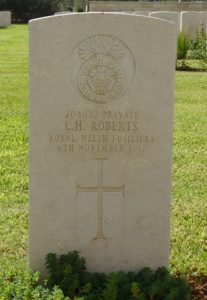
David Roberts, Private, 20253, Royal Welsh Fusiliers. David was born at Dolwyddelan in 1898. He was adopted as a young child by his uncle Rowland Owen and his aunt Catherine Owen (nee Jones), of 6, Summerhill Terrace, Blaenau Ffestiniog. David was underage when he enlisted at Blaenau Ffestiniog into the 14th Battalion, Royal Welsh Fusiliers soon after the outbreak of war. The battalion was raised at Llandudno by the Welsh National Executive Committee, joining 128 Brigade, 43rd (Welsh) Division and began training at Rhyl and Colwyn Bay. On 29 April 1915 the formation became renumbered to 113 Brigade, 38th (Welsh) Division, before moving to Winchester in the summer of 1915 to complete its training. The Division moved to France on 2 December 1915 and moved to the Nursery Sector near Fleurbaix for trench initiation alongside the Guards Division. The Division then held a sector of the line near Cuinchy before marching south to the Somme sector in June 1916 to take part in the assault on Mametz Wood. The 14th RWF marched to Mametz Village on 5 July, before relieving 91 Brigade in the front line at Quadrangle Trench, whilst the division prepared to assault the wood. David was killed in action here at Quadrangle Trench on 6 July 1916, the day prior to the divisions first assault upon the wood. The 18-year-old has no known grave and is commemorated on the Thiepval Memorial, France. David is not commemorated on the Dolwyddelan War Memorial.
John Roberts, Private, 9603, Royal Welsh Fusiliers. John was the son of Hugh Roberts and Margaret Roberts, of Bronllan, Dolwyddelan. He had enlisted into the Royal Welsh Fusiliers as a young man. John embarked for France with the 2nd Battalion, Royal Welsh Fusiliers on 13 August 1914. The battalion was initially placed on Lines of Communication at Rouen, before joining 19 Brigade at Valenciennes, taking part in the retreat to the Marne with the BEF. Following the Battles of the Marne and the Aisne, 19 Brigade moved to Flanders with the BEF, and eventually took over the La Boutillerie sector after becoming attached to the 6th Division. John was then transferred to the 1st Battalion, Royal Welsh Fusiliers, which had landed at Zeebrugge on 7 October 1914 attached to 22 Brigade, 7th Division. The 1st RWF had gone to Zeebrugge to defend the port, but it was already in the process of falling to the Germans, so the 7th Division moved out of the city, marching via Bruges to Ostend, where the Division then entrained for Ghent. The Division then marched to Meirelbeke, and dug in defensive positions, in support of the French and Belgians. It soon became apparent that the Germans had broken through the Belgian lines, so on 11 October the 7th Division received orders to withdraw, reaching Hansbeke by the following day, and over the coming days continued to withdraw, marching through Thielt to Roulers, and by 14 October reached Ypres, becoming the first British Division to hold the city. The remainder of the BEF moved to Ypres from the Marne soon afterwards, in time to take part in the desperate defence of Ypres, when the Germans began attacking the city on 19 October. Following the closure of the First Battle of Ypres, the 7th Division moved to positions near Neuve-Chapelle and began to rotate for duty in the front-line trenches. On 13 January 1915 the 1st RWF moved into the line, relieving the 8th Royal Scots, remaining there until being relieved on 25 January and moved into billets at Rue Bataille, where 50 reinforcements joined the battalion. On 29 January the battalion moved back into the line, taking over positions at Le Touquet. John was among five men killed in action here the following day, on 30 January 1915. He has no known grave so is commemorated on the Ploegsteert Memorial, Belgium.
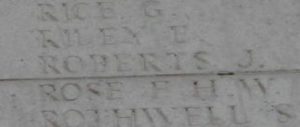
John Roberts, Private, DM2/171293, Royal Army Service Corps. John was born in 1897, the son of William Roberts and Catherine Roberts, of Bod Gwynedd, Dolwyddelan. He worked on his parent’s farm prior to the war. John enlisted into the Army Service Corps and trained as a driver, before being drafted out to France, joining the 11th Divisional Reserve Motor Transport Company. The 11th (Northern) Division had moved to France in July 1916, following service in Gallipoli and Egypt, and saw its first major action in France during the Battle of Flers-Courcelette during the Somme Offensive. The division wintered on the Ancre, then in the following spring moved to Flanders, taking part in the Battle of Messines Ridge. The division later fought at the Battle of Langemarck during the Third Battle of Ypres, then saw further fighting at the Battle of Polygon Wood, then at the Battle of Broodseinde and the Battle of Poelcapelle. The Division didn’t see any more major fighting for some months after the Passchendaele Offensive had been closed down, until fighting in August 1918 at the Battle of the Scarpe, during the Second Battles of Arras, taking part in the great offensive that ultimately won the war. John survived the war but sadly died of influenza in France on 7 December 1918. The 21-year-old was buried in Caudry British Cemetery, France.
William Roberts, Private, 21703, Welsh Regiment. William was born in 1883, the son of Edward Roberts and Alice Roberts, of Capel Gwyn, Ffestiniog. He worked as a farm labourer at Nefyn by 1911, then came to Dolwyddelan to work at some time prior to the war. William then left to work in the South Wales valleys and enlisted at Bridgend into the 13th Battalion, Welsh Regiment. The battalion was raised as the 2nd Rhondda Battalion before moving to Rhyl to join 129 Brigade, 43rd (Welsh) Division. The division trained in North Wales over the coming months, suffering from lack of arms and uniforms, then on 29 April 1915 became renumbered to the 38th (Welsh) Division. The division moved to Winchester in August 1915 to complete its training, before beginning to embark for France on 2 December, moving to the Nursery Sector at Fromelles for trench initiation and training. During June 1916 the Division marched south to the Somme, and on 7 July 1916 attacked Mametz Wood. The initial attack failed, and it was three days later, on 10 July, that a fresh attack was mounted. After two days of heavy hand to hand fighting within the wood, the Germans withdrew, and the battered Welshmen moved via Hébuterne to Boesinghe, on the Yser Canal, where it remained until launching its attack on Pilckem Ridge on 31 July 1917. The 15th Welsh remained in the line, and also took part in the Battle of Langemarck, before the entire Division was moved to positions near Armentieres over the winter. After the Germans launched their offensive on the Somme on 21 March 1918, the Division was moved back to the Somme, and took up positions north of Albert, around Aveluy Wood. On 10 May 1918 the 13th Welsh observed an assault by the 15th Welsh on Aveluy Wood, which failed due to the covering artillery fire falling short. On the following morning the 13th Welsh moved into the front line in the wood, relieving the battered 15th Welsh. William was wounded by enemy artillery during the relief and was evacuated to the 29th Casualty Clearing Station at Gézaincourt, where he died of his wounds on 12 May 1918. The 35-year-old was buried in Bagneux British Cemetery, Gézaincourt, France.
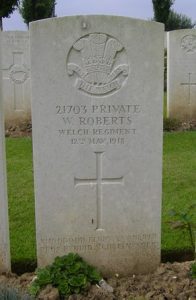
Richard Thomas, Private, 44277, Royal Welsh Fusiliers. Richard was born in 1892, the son of John Owen Thomas and Jane Thomas (nee Price), of Church Street, Dolwyddelan. He worked as a painter after leaving school. Richard married Fanny Roberts at Llanrwst Registry Office on 29 May 1914, and the couple settled at Cynwyd View, Dolwyddelan, where their two children were born. Richard enlisted at Wrexham into the Royal Welsh Fusiliers on 8 August 1916 and was posted to Kinmel Park to join the 21st Battalion, Royal Welsh Fusiliers. On 17 January 1917 Richard was drafted to France and was posted from the Infantry Base Depot to the 14th Battalion, Royal Welsh Fusiliers. The battalion was attached to 113 Brigade, 38th (Welsh) Division and was by then at Ypres, holding the Canal Bank sector at Boesinghe. The infantry battalions of the Division then began carrying out the normal pattern of rotation in the trenches, four days in the front, four in support and four in reserve, whilst also working on trench improvement, digging new trenches, and also carrying out regular patrols and trench raids. On 31 July 1917 the Division launched its famous assault on the Pilckem Ridge, capturing Iron Cross and reaching its objective of the Steenbeek, then played a supporting role in the Battle of Langemarck. The Division was transferred to the Sailly-sur-la-Lys sector in September and remained in the area over the winter before being moved to positions north of Albert, at Bouzincourt Ridge, at the end of March 1918, relieving the battered 2nd and 47th Divisions. It held this sector, again carrying out minor operations and trench raids, over the coming months. On 21 August 1918 the Division launched an assault across the river Ancre, as part of the greater Allied offensive, and over the coming days captured Thiepval Ridge, Pozieres, Mametz Wood and High Wood, whilst advancing across the old Somme battlefields of 1916. The advance saw the Division take part in several costly assaults over the coming weeks, famously crossing the Canal du Nord, and saw especially heavy fighting around Dessart Wood. By 17 September the division had reached positions facing the strongly defended town of Gouzeaucourt and on the following morning, 18 September 1918, launched its assault upon the town. Richard was killed in action during the fighting that day. The 26-year-old is buried in Gouzeaucourt New British Cemetery, France.
World War Two, 1939-1945
Samuel Evans, Pilot Officer, 54256, Royal Air Force. Samuel was born at Ludlow on 1 October 1922, the son of Samuel Evans and Jemima Evans (nee Rowley). His father was a gamekeeper from Ruabon, and the family had moved to live at several places around the country before settling at Dolwyddelan. Samuel enlisted into the Royal Air Force and after training as a Wireless Operator/ Air Gunner was posted to 26 Squadron, South African Air Force, which was based at Takoradi, Ghana (Gold Coast) on the West Coast of Africa. The role of the squadron was to carry out anti-submarine (U-boat) patrols and convoy escort duties, in the Atlantic, and was equipped with a variety of Vickers Wellington twin-engine aircraft. On 18 December 1943, Samuel took off from Takoradi as one of the six-man crew of a Vickers Wellington XI, Serial HZ526, on a routine flight over the Atlantic, hunting enemy submarines. No trace of the aircraft was ever found, and it was suspected to have been brought down by enemy anti-aircraft fire over the Atlantic. Samuel has no known grave and is commemorated on the Malta Memorial, Malta.
Arwyn Morris Jones, Fusilier, 14173181, Royal Welch Fusiliers. Arwyn was born in about 1927, the son of Pierce Jones and Margaret Mabel Jones (nee Morris), of Dolwyddelan. He did not serve during the war, as he was too young, but enlisted into the Royal Welch Fusiliers and was posted to Germany with the 1st Battalion, Royal Welch Fusiliers, as part of the British Army on the Rhine. Arwyn was killed during a road accident in Germany on 8 September 1947. The 20-year-old was buried in Munster Heath War Cemetery, Germany. Arwyn is not commemorated on the Dolwyddelan War Memorial.
Charles Jones, Donkeyman, Merchant Navy. Charles was born in about 1902, the son of David Jones and Margaret Jones, of Ty’n-y-Bryn, Dolwyddelan. He left home to join the Merchant Navy and by the time that war broke out was serving as a Donkeyman and Greaser. In 1941 Charles was posted aboard the former US ship, SS Empire Heron. He had made a crossing of the Atlantic aboard her during the summer of 1941, then after filling up her holds with a cargo of over 7,500 tons of sulphur, Empire Heron left Freeport, Texas to join Convoy SC-48. During the early hours of 16 October 1941, Empire Heron was halfway across the Atlantic when she was struck by two torpedoes which had been fired by the German submarine U-568. The ship sank fast, with the loss of 42 of her crew of 43 men. Charles was 39 years old when he was killed that morning. He has no known grave but the sea, so is commemorated on the Tower Hill Memorial, London. Her one survivor was picked up by a Royal Navy destroyer, which was herself sunk a day later.
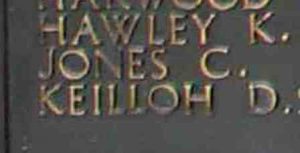
Hugh Llewelyn Roberts, Lance Corporal, 4196545, The Parachute Regiment. Hugh was born on 17 October 1918, the son of Hugh Roberts and Margaret Roberts (nee Edwards), of 7, Castle Terrace, Dolwyddelan. He worked as a shop assistant for his mother prior to the war. Hugh enlisted into the 10th Battalion, Royal Welch Fusiliers. The battalion was originally a standard infantry battalion but was converted to the 6th (Royal Welch) Parachute Battalion in August 1942, joining the newly raised 2nd Parachute Brigade, 1st Airborne Division. The men then had to undergo a twelve-day parachute training course before being presented with their maroon beret and parachute wings. The 1st Airborne Division was sent to Tunisia in 1943, to prepare for operations in Sicily and Italy. The 2nd Parachute Brigade did not take part in the initial operations in Sicily, so when the landings on mainland Italy were being planned, only the 2nd Parachute Brigade and 4th Parachute Brigade were up to full strength. They were then briefed for their part in the invasion, codenamed Operation Slapstick, which was to be an amphibious landing at the port of Taranto. The 2nd Parachute Brigade left Bizerta on 8 September and landed unopposed on 10 September 1943, however one of the transport ships carrying men of the 6th Parachute Battalion, HMS Abdiel, struck a mine and sank. Hugh was among the 58 men lost when HMS Abdiel sank that day. The 24-year-old has no known grave, so is commemorated on the Brookwood 1939-1945 Memorial, Surrey.
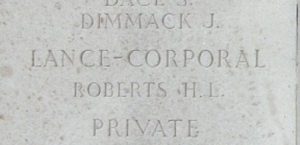
John Roberts, Gunner, 1722230, Royal Artillery. John was born on 5 January 1915, the son of Annie Roberts, of Tan Rallt, Dolwyddelan. He worked as a labourer prior to the war. John enlisted into the Royal Artillery and was posted to the 7/4th Maritime Regiment, Royal Artillery as a DEMS Gunner. He was then posted aboard the Motor Vessel MV Vancouver Island. The ship was the German vessel ‘Weser’ which had been captured by the Canadians early in the war whilst carrying supplies for Kriegsmarine ships and was taken over by the Ministry of War Transport, before being renamed as the MV Vancouver Island. She then began work carrying vital war materials across the dangerous Atlantic route to Britain from America. On her final voyage, Vancouver Island left Montreal on 24 September 1941 carrying a general cargo of copper, aluminium, zinc, asbestos and steel. She sailed to Quebec before setting off across the Atlantic for Cardiff, via Belfast on 9 October. During the night of 15 October 1941, the unescorted Vancouver Island was spotted by the German submarine U-558 which fired a spread of three torpedoes at her, two of which hit its target. The stricken ship shuddered to a halt and the Germans fired two more torpedoes at her, sinking her. Vancouver Island went down quickly with the loss of all 105 of her crew. John was 26 years old when he was killed that night. He has no known grave but the sea, so is commemorated on the Plymouth Naval Memorial, Devon.
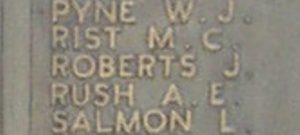
Robert William Williams, Private, 4038303, King’s Shropshire Light Infantry. Robert was born on 29 August 1913, the son of Robert Morris Williams and Margaret Mary Williams, of Penbryn Bach, Dolwyddelan. He worked on his parent’s farm prior to the war. Robert enlisted into the army soon after the outbreak of war and was posted to the 1st Battalion, King’s Shropshire Light Infantry. The battalion was a regular army unit, which was attached to the 3rd Infantry Brigade, 1st Infantry Division, and had been in France with the BEF at the outbreak of war. The battalion then fought in the retreat to Dunkirk, before being evacuated to Britain. After a lengthy period on home defence duties, the division arrived in North Africa on 9 March 1943, moving to the Medjez-Bou Arada area of Tunisia, to join in the Tunisian campaign. On 21 April the division took part in its first major battle in Tunisia, when six German battalions attacked the British 1st and the 4th Divisions near Medjez el Bab. The 3rd Brigade bore the brunt of the attack, but the German’s were repulsed. On the following day the Allies launched Operation Vulcan and began to drive towards Tunis. Heavy fighting raged over the coming weeks, as the Germans fought back bravely. Robert was killed during heavy fighting on 5 May 1943, during the capture of a ridge between Grich el Oued and Gueriat el Atach. The 29-year-old is buried in Massicault War Cemetery, Tunisia.
William Caradoc Williams, Able Seaman, D/JX 176889, Royal Navy. William was born on 17 March 1918, the son of William Lloyd Williams and Grace Ellen Williams (nee Evans), of Del-y-Bryn, Dolwyddelan. He enlisted into the Royal Navy and was posted aboard the Hunt-class destroyer HMS Limbourne. The destroyer had completed commissioning on 24 October 1942, before beginning work on escort duties, firstly escorting the battleship HMS Howe out to Gibraltar and then the aircraft carrier HMS Victorious and the battleship HMS Duke of York back to Britain from the Mediterranean, following Operation Torch. Limbourne then joined the 15th Destroyer Flotilla based at Devonport and began escorting convoys between Britain and Gibraltar. On 23 October 1943, Limbourne was sailing with the light cruiser HMS Charybdis and five other destroyers, when they were engaged by a number of large German torpedo boats. Despite their superiority in firepower, Charybdis was sunk during the ensuing battle, whilst Limbourne was hit in the bow by a torpedo which exploded, killing some forty men. Attempts to tow the stricken Limbourne back to port failed, and she was scuttled soon afterwards. William was killed during the torpedo strike. The 25-year-old has no known grave but the sea, so is commemorated on the Plymouth Naval Memorial, Devon.
